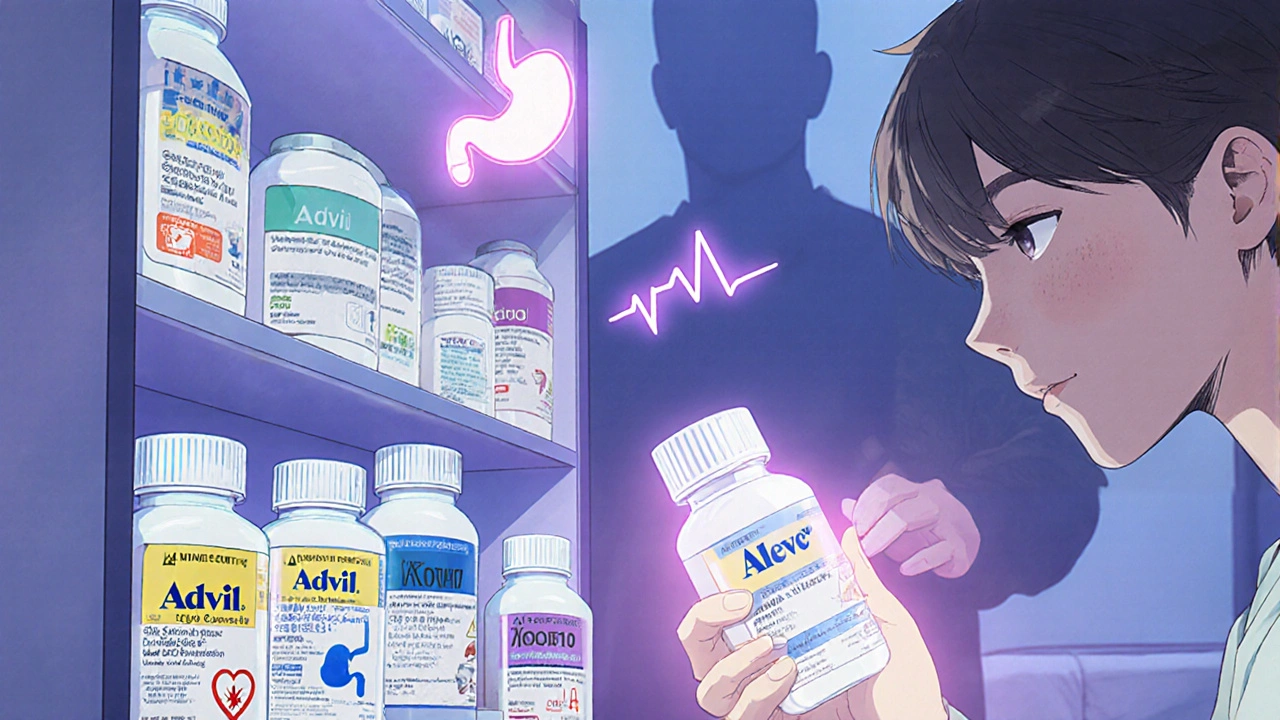Every year, millions of people reach for ibuprofen or naproxen to ease a headache, back pain, or menstrual cramps. These are the two most common over-the-counter NSAIDs-available on every pharmacy shelf, often in the same aisle as aspirin and acetaminophen. But just because they’re easy to buy doesn’t mean they’re safe to use without limits. In fact, using them the wrong way can land you in the hospital.
What You’re Really Taking
When you grab a bottle of Advil or Motrin, you’re getting ibuprofen-200 mg per tablet. Aleve contains naproxen sodium, 220 mg per tablet. These aren’t just painkillers. They’re powerful drugs that block enzymes responsible for inflammation, pain, and fever. But they also block enzymes that protect your stomach lining and help your kidneys function properly.
The difference between them isn’t just brand names. Ibuprofen works fast but doesn’t last long-its effects fade in 4 to 6 hours. That’s why you might take it three or four times a day. Naproxen lasts longer-up to 12 hours-so you only need to take it twice a day. That might sound convenient, but it also means it stays in your system longer, which can increase the risk of side effects if you use it too often.
The Hidden Risks
Most people think NSAIDs are harmless because they’re sold without a prescription. But the FDA updated warnings in 2020 after reviewing data from over 1.9 million patients. The message was clear: NSAIDs increase your risk of heart attack and stroke, even within the first few weeks of use. And that risk doesn’t go away if you stick to the label. It just grows slowly over time.
One study tracking 635,000 people found that taking high doses of ibuprofen (over 1,500 mg daily) raised heart failure risk by 61%. Naproxen’s risk was lower-around 20%-but still present. The FDA’s own analysis shows naproxen has the most favorable cardiovascular profile among NSAIDs, but that doesn’t mean it’s safe. It just means it’s less dangerous than ibuprofen in this specific area.
Then there’s your stomach. NSAIDs are the leading cause of serious gastrointestinal bleeding in adults over 60. They don’t just cause heartburn-they can eat holes in your stomach lining. Studies show NSAID users are two to four times more likely to develop ulcers than people who don’t take them. One Reddit user reported being hospitalized after taking 1,600 mg of ibuprofen daily for three weeks. That’s 400 mg over the OTC daily limit.
Who Should Avoid Them Completely
These aren’t just general warnings. Certain people should never take OTC NSAIDs without talking to a doctor first:
- People with heart disease, high blood pressure, or a history of stroke
- Those with kidney problems or who are dehydrated
- Anyone who’s had stomach ulcers or bleeding
- People over 65
- Those taking blood thinners like warfarin or aspirin
- Pregnant women after 20 weeks (can cause serious fetal kidney problems)
- People with asthma triggered by painkillers
And here’s something most people don’t know: if you take low-dose aspirin to protect your heart, ibuprofen can interfere with it. Taking ibuprofen within 8 hours of your aspirin can block aspirin’s ability to prevent clots. Naproxen doesn’t do this as much-but you still shouldn’t mix them without checking with your doctor.

What the Labels Don’t Tell You
The Drug Facts label on your bottle says you can take up to 1,200 mg of ibuprofen a day. That’s six 200 mg tablets. But here’s the catch: that’s the absolute maximum. It’s not a target. The FDA and Mayo Clinic both say: take the lowest dose for the shortest time possible.
Most minor aches don’t need 600 mg of ibuprofen. Two 200 mg tablets (400 mg total) every 6 hours is usually enough. And if you’re still hurting after 10 days, you’re not treating the cause-you’re masking it. That’s when you need to see a doctor, not buy another bottle.
Naproxen’s label says you can take up to 660 mg a day (three 220 mg tablets). But the official maximum is 600 mg. That extra 60 mg? It’s not a bonus. It’s a risk. And taking it every day for two weeks? That’s how people end up with acute kidney injury. The FDA’s adverse event database has documented cases of this exact scenario.
What to Take Instead
For most people, acetaminophen (paracetamol) is a safer first choice for pain and fever. It doesn’t hurt your stomach or raise your blood pressure. But it’s not magic-it won’t reduce inflammation. So if you have arthritis, a sprained ankle, or tendonitis, it won’t help as much as an NSAID.
But here’s the trade-off: acetaminophen can damage your liver if you take too much. The safe limit is 3,000 mg a day-lower than the old 4,000 mg guideline. That’s six 500 mg tablets. If you’re drinking alcohol, even one drink a day, you should stay under 2,000 mg. Many cold and flu meds contain acetaminophen. You could easily overdose without realizing it.
Topical NSAIDs are another option. Diclofenac gel, for example, delivers pain relief directly to your knee or shoulder with far less risk to your stomach or heart. It’s not strong enough for full-body pain, but for localized issues, it’s a smart alternative.

Real Stories, Real Consequences
Drugs.com has over 1,800 reviews for ibuprofen. Only 45% say it worked well. Thirty-two percent reported stomach problems. Naproxen’s rating is even lower at 5.8 out of 10, with similar complaints.
One user wrote: “200 mg ibuprofen works perfectly for my menstrual cramps when taken with food.” That’s the right way to use it-low dose, short term, with food.
Another wrote: “I took 800 mg ibuprofen daily for months for back pain and ended up with stomach ulcers requiring hospitalization.” That’s the wrong way. Chronic pain needs a plan, not a pill.
A 68-year-old man in a 2024 FDA report took the max dose of naproxen for 14 days straight. He ended up in the ER with kidney failure. He didn’t know there was a 10-day limit. He wasn’t alone.
A 2023 survey found 63% of people didn’t know OTC NSAIDs shouldn’t be used longer than 10 days. That’s not ignorance-it’s a systemic failure. Labels are too small. Warnings are buried. Pharmacists are busy. And patients assume “over-the-counter” means “safe.”
How to Use Them Safely
Here’s a simple checklist for using ibuprofen or naproxen without risking your health:
- Check the label. Know exactly how much you’re taking per dose.
- Never exceed 1,200 mg of ibuprofen or 600 mg of naproxen in 24 hours.
- Take it with food or milk to protect your stomach.
- Don’t use it for more than 10 days in a row without seeing a doctor.
- Don’t combine with alcohol, blood thinners, or other NSAIDs.
- Stop immediately if you notice black stools, chest pain, swelling in your legs, or sudden changes in urination.
- Consider topical gels for localized pain.
- Use acetaminophen for fever or non-inflammatory pain.
If you’re taking these for chronic pain-back pain, arthritis, migraines-you’re not fixing the problem. You’re covering it up. That’s when physical therapy, weight management, stretching, or even cognitive behavioral therapy become the real solutions.
What’s Next?
The science keeps evolving. A 2024 study in The Lancet found even short-term NSAID use (under 7 days) raised heart attack risk by 20% in people with existing heart conditions. The American Heart Association now says NSAIDs should be avoided in patients with cardiovascular disease-if possible.
Pharmacies are starting to stock more topical NSAIDs. The FDA is watching for new patterns through its Sentinel Initiative. But until then, the burden is on you.
You don’t need to avoid these drugs forever. But you do need to treat them like medicine-not candy. A little knowledge goes a long way. A little care saves your stomach, your kidneys, and your heart.
Can I take ibuprofen and naproxen together?
No. Taking both together doesn’t give you better pain relief-it doubles your risk of stomach bleeding, kidney damage, and heart problems. If one isn’t working, switch to acetaminophen or talk to your doctor. Never combine NSAIDs.
Is naproxen safer than ibuprofen?
For heart risk, yes-naproxen has a slightly better safety profile according to FDA reviews. But for stomach bleeding, naproxen may be worse at equivalent anti-inflammatory doses. Neither is safe for long-term use. The best choice is the lowest dose for the shortest time.
Can I take NSAIDs if I’m on blood pressure medication?
They can interfere. NSAIDs reduce the effectiveness of some blood pressure drugs and can cause fluid retention, which raises blood pressure. If you’re on ACE inhibitors, diuretics, or beta-blockers, talk to your doctor before using ibuprofen or naproxen.
What should I do if I accidentally took too much?
If you took more than the daily limit in one day, stop taking it immediately. Drink water and monitor for symptoms: nausea, vomiting, dizziness, ringing in the ears, or dark stools. If you feel unwell or took more than double the dose, go to the ER. Overdoses can cause kidney failure or internal bleeding.
Are OTC NSAIDs safe for teens and kids?
Ibuprofen is approved for children over 6 months, but dosing must be based on weight-not age. Never give aspirin to children or teens with a virus-it can cause Reye’s syndrome, a rare but deadly condition. Always check with a pediatrician before giving any OTC painkiller to a child.
Why do some people say NSAIDs help their arthritis but others say they made it worse?
NSAIDs reduce inflammation and pain, so they help symptoms. But they don’t stop joint damage. Long-term use can mask worsening arthritis, leading to more damage before it’s noticed. Plus, repeated use can harm the kidneys or stomach, making overall health worse. Physical therapy and weight control do more for long-term joint health than any pill.
Is it okay to take NSAIDs before a workout to prevent soreness?
No. Taking NSAIDs before exercise doesn’t prevent soreness-it masks pain signals your body uses to tell you you’re overdoing it. This can lead to injury. Muscle soreness is part of recovery. Let it happen. Stretch, hydrate, and rest instead.
If you’ve been using ibuprofen or naproxen regularly for months or years, it’s time to talk to your doctor. There are better, safer ways to manage pain-and you deserve to feel better without risking your health.



9 Comments
Jenny Lee
November 17, 2025 AT 21:46Just took two ibuprofen for my headache and immediately felt better. No drama, no hospital trips. Sometimes simple works.
Kevin Jones
November 18, 2025 AT 04:22The pharmacokinetic profile of ibuprofen is inherently transient-Cmax at 1.5–2h, t½ ~2h-demanding frequent dosing. Naproxen, with its longer t½ (~14h), creates sustained COX inhibition, increasing off-target systemic exposure. This isn't 'risk'-it's biopharmaceutical inevitability.
Saket Sharma
November 18, 2025 AT 05:03NSAIDs are just the tip. The FDA knows they're dangerous but won't pull them-pharma profits > public health. You think this is about safety? It's about control. The system wants you dependent on pills, not solutions.
Joshua Casella
November 18, 2025 AT 22:39Listen-this is exactly why we need better public health literacy. People treat OTC meds like candy because no one teaches them otherwise. If your kid can't read a Drug Facts label by 16, we’ve failed. I’ve handed out printed guides at pharmacies for years. Someone has to start.
Erica Lundy
November 19, 2025 AT 07:18It is axiomatic that the commodification of pharmaceuticals inevitably dilutes their perceived risk profile. The semantic framing of ‘over-the-counter’ as synonymous with ‘benign’ constitutes a profound epistemological error-one that is perpetuated by regulatory inertia and commercial marketing. The biological consequences of cyclooxygenase inhibition are neither trivial nor negotiable.
Alexis Paredes Gallego
November 19, 2025 AT 17:00Wait-so the FDA says NSAIDs cause heart attacks… but they’re still sold next to gum and candy? And you think that’s normal? This isn’t negligence-it’s intentional. They want you sick. They want you on lifelong meds. Wake up. The system is rigged.
Shravan Jain
November 20, 2025 AT 19:02acetaminophen = liver killer. NSAID = stomach killer. So what's the answer? Nothing. Just accept you're gonna die from something. Pharma made sure of it. Also, typo in the post: 'diclofenac gel' is spelled wrong. Fix it.
Brandon Lowi
November 20, 2025 AT 19:45America’s pain crisis? It’s not the pills-it’s the people who think a pill fixes everything. We’ve turned our bodies into vending machines: insert cash, get relief. Meanwhile, real solutions-movement, sleep, stress reduction-are treated like hippie nonsense. We’re not broken-we’re lazy. And now we’re dying because we refuse to move.
Premanka Goswami
November 22, 2025 AT 18:10They don’t want you to know this-but NSAIDs were designed by Big Pharma to keep you docile. The 10-day limit? It’s not in the label because they want you addicted. They know if you stop, you’ll ask: ‘Why am I in pain?’ And then… you might start asking who’s really to blame.